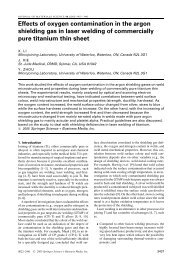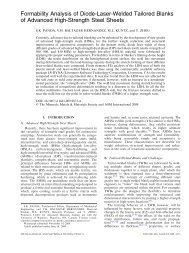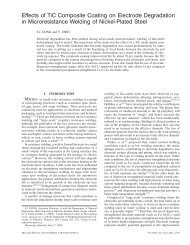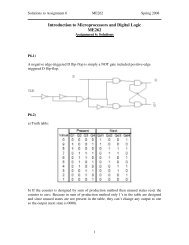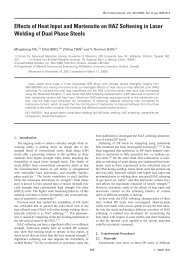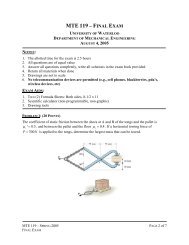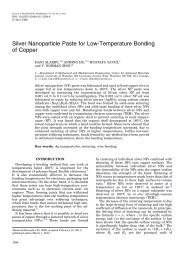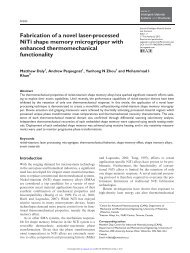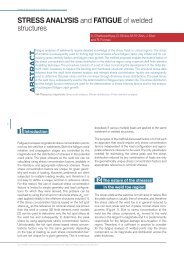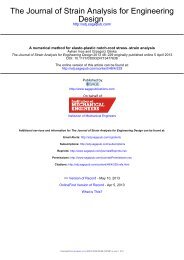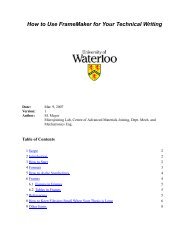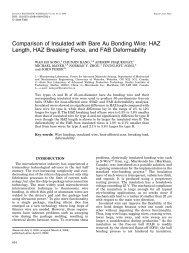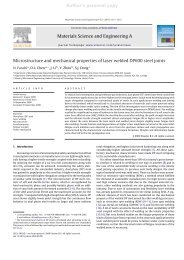Effect of PVP on the low temperature bonding process using polyol ...
Effect of PVP on the low temperature bonding process using polyol ...
Effect of PVP on the low temperature bonding process using polyol ...
You also want an ePaper? Increase the reach of your titles
YUMPU automatically turns print PDFs into web optimized ePapers that Google loves.
Home Search Collecti<strong>on</strong>s Journals About C<strong>on</strong>tact us My IOPscience<br />
<str<strong>on</strong>g>Effect</str<strong>on</strong>g> <str<strong>on</strong>g>of</str<strong>on</strong>g> <str<strong>on</strong>g>PVP</str<strong>on</strong>g> <strong>on</strong> <strong>the</strong> <strong>low</strong> <strong>temperature</strong> b<strong>on</strong>ding <strong>process</strong> <strong>using</strong> <strong>polyol</strong> prepared Ag nanoparticle<br />
paste for electr<strong>on</strong>ic packaging applicati<strong>on</strong><br />
This article has been downloaded from IOPscience. Please scroll down to see <strong>the</strong> full text article.<br />
2012 J. Phys.: C<strong>on</strong>f. Ser. 379 012024<br />
(http://iopscience.iop.org/1742-6596/379/1/012024)<br />
View <strong>the</strong> table <str<strong>on</strong>g>of</str<strong>on</strong>g> c<strong>on</strong>tents for this issue, or go to <strong>the</strong> journal homepage for more<br />
Download details:<br />
IP Address: 166.111.49.22<br />
The article was downloaded <strong>on</strong> 21/08/2012 at 07:54<br />
Please note that terms and c<strong>on</strong>diti<strong>on</strong>s apply.
ECO-MATES 2011<br />
Journal <str<strong>on</strong>g>of</str<strong>on</strong>g> Physics: C<strong>on</strong>ference Series 379 (2012) 012024<br />
IOP Publishing<br />
doi:10.1088/1742-6596/379/1/012024<br />
<str<strong>on</strong>g>Effect</str<strong>on</strong>g> <str<strong>on</strong>g>of</str<strong>on</strong>g> <str<strong>on</strong>g>PVP</str<strong>on</strong>g> <strong>on</strong> <strong>the</strong> <strong>low</strong> <strong>temperature</strong> b<strong>on</strong>ding <strong>process</strong> <strong>using</strong><br />
<strong>polyol</strong> prepared Ag nanoparticle paste for electr<strong>on</strong>ic<br />
packaging applicati<strong>on</strong><br />
Jianfeng Yan 1 , Guisheng Zou 1 , Aiping Wu 1 , Jialie Ren 1 , Jiuchun Yan 2 , Anming<br />
Hu 3 , Lei Liu 3 , Y.Norman Zhou 1,3<br />
1.<br />
Department <str<strong>on</strong>g>of</str<strong>on</strong>g> Mechanical Engineering, Tsinghua University, Beijing 100084, China<br />
2.<br />
State Key Laboratory <str<strong>on</strong>g>of</str<strong>on</strong>g> Advanced Welding & Joining, Harbin Institute <str<strong>on</strong>g>of</str<strong>on</strong>g><br />
Technology, Harbin 150001, China<br />
3.<br />
Department <str<strong>on</strong>g>of</str<strong>on</strong>g> Mechanical and Mechatr<strong>on</strong>ics Engineering, University <str<strong>on</strong>g>of</str<strong>on</strong>g> Waterloo,<br />
200 University Avenue West, Waterloo, ON, N2L 3G1, Canada<br />
E-mail: yanjf09@mails.tsinghua.edu.cn<br />
Abstract. There has been an increasing interest in developing <strong>low</strong> <strong>temperature</strong> interc<strong>on</strong>necti<strong>on</strong><br />
<strong>process</strong> <strong>using</strong> metal nanoparticles. In this study <strong>the</strong> Ag nanoparticles (NPs) for this <strong>low</strong><br />
<strong>temperature</strong> b<strong>on</strong>ding <strong>process</strong> applicati<strong>on</strong>s were prepared based <strong>on</strong> <strong>the</strong> <strong>polyol</strong> method <strong>using</strong><br />
polyvinylpyrrolid<strong>on</strong>e (<str<strong>on</strong>g>PVP</str<strong>on</strong>g>) as <strong>the</strong> protecting agent. The effect <str<strong>on</strong>g>of</str<strong>on</strong>g> <str<strong>on</strong>g>PVP</str<strong>on</strong>g> <strong>on</strong> <strong>the</strong> Ag nanoparticle<br />
size, nanoparticle soluti<strong>on</strong> viscosity and <strong>the</strong> b<strong>on</strong>dability <str<strong>on</strong>g>of</str<strong>on</strong>g> <strong>the</strong> Ag nanoparticle paste were<br />
studied. The silver nanoparticle with diameter <str<strong>on</strong>g>of</str<strong>on</strong>g> 90 nm, 40 nm and 20 nm were syn<strong>the</strong>sized by<br />
adjusting <str<strong>on</strong>g>PVP</str<strong>on</strong>g> c<strong>on</strong>centrati<strong>on</strong>. The b<strong>on</strong>ding <strong>process</strong>es <strong>using</strong> different kind <str<strong>on</strong>g>of</str<strong>on</strong>g> Ag nanoparticle<br />
paste were c<strong>on</strong>ducted. The joint with shear strength <str<strong>on</strong>g>of</str<strong>on</strong>g> 50 MPa were formed <strong>using</strong> Ag<br />
nanoparticle (NP) paste prepared with appropriate <str<strong>on</strong>g>PVP</str<strong>on</strong>g> c<strong>on</strong>centrati<strong>on</strong>.<br />
1. Introducti<strong>on</strong><br />
Soldering technology based <strong>on</strong> tin/lead (Sn/Pb) solders has been playing an important role in<br />
electr<strong>on</strong>ic packaging. However, Pb and its compounds result in serious health threat to humans when<br />
deposing <strong>the</strong> Pb c<strong>on</strong>taining electr<strong>on</strong>ic devices in <strong>the</strong> envir<strong>on</strong>ment. Emerging regulati<strong>on</strong>s have targeted<br />
<strong>the</strong> eliminati<strong>on</strong> <str<strong>on</strong>g>of</str<strong>on</strong>g> Pb usage in electr<strong>on</strong>ic assemblies in many countries [1, 2]. Particularly, <strong>the</strong> high<br />
<strong>temperature</strong> solders are still widely used due to no suitable alternative. Therefore, <strong>the</strong>re is a str<strong>on</strong>g<br />
drive to find Pb-free alternatives especially for high <strong>temperature</strong> applicati<strong>on</strong>s.<br />
As Pb-free electr<strong>on</strong>ic interc<strong>on</strong>necti<strong>on</strong> materials, <strong>the</strong> <strong>low</strong> <strong>temperature</strong> b<strong>on</strong>ding technology <strong>using</strong><br />
metal nanoparticles (Ag, Cu, etc) have attracted people’s attenti<strong>on</strong> in <strong>the</strong> recent years [3-12]. As <strong>the</strong><br />
size <str<strong>on</strong>g>of</str<strong>on</strong>g> metal nanoparticles is reduced, <strong>the</strong>ir surface energy increases, which lead to some special<br />
properties such as increase <str<strong>on</strong>g>of</str<strong>on</strong>g> diffusi<strong>on</strong> coefficient and decrease <str<strong>on</strong>g>of</str<strong>on</strong>g> sintering <strong>temperature</strong> [13-16]. Due<br />
to <strong>the</strong> size effect <strong>the</strong> metal nanoparticles can be used as <strong>the</strong> <strong>low</strong> <strong>temperature</strong> b<strong>on</strong>ding materials. After<br />
<strong>the</strong> b<strong>on</strong>ding is completed, <strong>the</strong> nanoparticles are changed into microscaled or bulk materials.<br />
C<strong>on</strong>sequently, <strong>the</strong> apparent melting point <str<strong>on</strong>g>of</str<strong>on</strong>g> b<strong>on</strong>ding materials increases to that <str<strong>on</strong>g>of</str<strong>on</strong>g> <strong>the</strong> bulk materials.<br />
Published under licence by IOP Publishing Ltd<br />
1
ECO-MATES 2011<br />
Journal <str<strong>on</strong>g>of</str<strong>on</strong>g> Physics: C<strong>on</strong>ference Series 379 (2012) 012024<br />
IOP Publishing<br />
doi:10.1088/1742-6596/379/1/012024<br />
Therefore, <strong>the</strong> metal nanoparticle paste, which can be sintered at <strong>low</strong> <strong>temperature</strong>, has <strong>the</strong> potential to<br />
be a lead-free, high-performance interc<strong>on</strong>nect material[17]. Based <strong>on</strong> this principle, <strong>the</strong> b<strong>on</strong>ding<br />
technique <strong>using</strong> metal nanoparticles (Ag, Cu, etc) has been studied by several research groups [3-12].<br />
Usually <strong>the</strong> metal nanoparticle paste was prepared by mixing <strong>the</strong> organic comp<strong>on</strong>ents to <strong>the</strong><br />
commercial nanoparticles in order to prevent <strong>the</strong> self-cohesi<strong>on</strong>. However, <strong>the</strong> added organic<br />
comp<strong>on</strong>ents will bring detrimental effect to <strong>the</strong> sintering and <strong>the</strong> b<strong>on</strong>ding <strong>process</strong>. Recently, our group<br />
has developed a new method to prepare metal nanoparticle paste, which c<strong>on</strong>tains <strong>low</strong> organic<br />
comp<strong>on</strong>ent, based <strong>on</strong> <strong>the</strong> <strong>polyol</strong> method. This new Ag nanoparticle paste was prepared through <strong>the</strong><br />
<strong>polyol</strong> syn<strong>the</strong>sis <str<strong>on</strong>g>of</str<strong>on</strong>g> Ag naoparticles and <strong>the</strong> subsequent c<strong>on</strong>centrati<strong>on</strong> without a fur<strong>the</strong>r additi<strong>on</strong> <str<strong>on</strong>g>of</str<strong>on</strong>g><br />
organic comp<strong>on</strong>ent. Thus <strong>the</strong> organic c<strong>on</strong>tent in this new nanoparticle paste is significantly <strong>low</strong>er than<br />
that in <strong>the</strong> c<strong>on</strong>venti<strong>on</strong>al Ag nanoparticle paste [7, 9-12]. During our Ag nanoparticle preparati<strong>on</strong>,<br />
polyvinylpyrrolid<strong>on</strong>e (<str<strong>on</strong>g>PVP</str<strong>on</strong>g>) was used as <strong>the</strong> protecting agent to prevent <strong>the</strong> self-cohesi<strong>on</strong> <str<strong>on</strong>g>of</str<strong>on</strong>g> <strong>the</strong><br />
chemical reducti<strong>on</strong> created Ag nanoparticles. In this study, <strong>the</strong> effect <str<strong>on</strong>g>of</str<strong>on</strong>g> <strong>the</strong> added<br />
polyvinylpyrrolid<strong>on</strong>e (<str<strong>on</strong>g>PVP</str<strong>on</strong>g>) c<strong>on</strong>centrati<strong>on</strong> <strong>on</strong> <strong>the</strong> Ag nanoparticle size, <strong>the</strong> Ag soluti<strong>on</strong> viscosity and<br />
<strong>the</strong> b<strong>on</strong>dability <str<strong>on</strong>g>of</str<strong>on</strong>g> Ag nanoparticle paste were studied.<br />
2. Experimental procedure<br />
Different kinds <str<strong>on</strong>g>of</str<strong>on</strong>g> silver nanoparticle soluti<strong>on</strong>s were syn<strong>the</strong>sized by <strong>the</strong> modified <strong>polyol</strong> <strong>process</strong> in this<br />
study[18]. First, silver nitrite was dissolved into ethylene glycol (EG) to form a soluti<strong>on</strong> with an<br />
AgNO 3 c<strong>on</strong>centrati<strong>on</strong> <str<strong>on</strong>g>of</str<strong>on</strong>g> 0.15 M. On <strong>the</strong> o<strong>the</strong>r hand, <strong>the</strong> EG soluti<strong>on</strong> <str<strong>on</strong>g>of</str<strong>on</strong>g> polyvinylpyrrolid<strong>on</strong>e (<str<strong>on</strong>g>PVP</str<strong>on</strong>g>-<br />
K30, with viscosity about 2.5mPa.s) with a given <str<strong>on</strong>g>PVP</str<strong>on</strong>g> c<strong>on</strong>centrati<strong>on</strong> such as 0.045 M (mol/L), 0.45 M,<br />
1.35 M, were prepared. After <strong>the</strong> two kinds <str<strong>on</strong>g>of</str<strong>on</strong>g> menti<strong>on</strong>ed soluti<strong>on</strong>s were heated to <strong>the</strong> chemicalreacti<strong>on</strong><br />
<strong>temperature</strong> <str<strong>on</strong>g>of</str<strong>on</strong>g> 160 o C, at a c<strong>on</strong>stant heating rate <str<strong>on</strong>g>of</str<strong>on</strong>g> 20 o C/min. The <str<strong>on</strong>g>PVP</str<strong>on</strong>g> soluti<strong>on</strong> was injected<br />
into <strong>the</strong> silver nitrite soluti<strong>on</strong> at a c<strong>on</strong>stant rate. The color <str<strong>on</strong>g>of</str<strong>on</strong>g> <strong>the</strong> soluti<strong>on</strong> changed from <strong>the</strong> colorless to<br />
gray, indicating <strong>the</strong> precipitati<strong>on</strong> <str<strong>on</strong>g>of</str<strong>on</strong>g> Ag NPs. When <strong>the</strong> reacti<strong>on</strong> was completed, <strong>the</strong> soluti<strong>on</strong> was<br />
rapidly cooled by adding chilled dei<strong>on</strong>ized (DI) water. Three kinds <str<strong>on</strong>g>of</str<strong>on</strong>g> Ag NP pastes (A, B and C) were<br />
prepared by directly c<strong>on</strong>densing <strong>the</strong> chemically reduced Ag NP soluti<strong>on</strong>s <strong>using</strong> different <str<strong>on</strong>g>PVP</str<strong>on</strong>g><br />
c<strong>on</strong>centrati<strong>on</strong> (0.045 M, 0.45 M, 1.35 M ) without a fur<strong>the</strong>r additi<strong>on</strong> <str<strong>on</strong>g>of</str<strong>on</strong>g> organic comp<strong>on</strong>ent.<br />
The b<strong>on</strong>dability <str<strong>on</strong>g>of</str<strong>on</strong>g> Ag nanoparticle pastes (A, B and C) prepared with different <str<strong>on</strong>g>PVP</str<strong>on</strong>g><br />
c<strong>on</strong>centrati<strong>on</strong>s were investigated by b<strong>on</strong>ding <strong>the</strong> silver plated Cu discs, which simulate <strong>the</strong> metalcoated<br />
semic<strong>on</strong>ductor chip and substrate respectively, in air. The shape <str<strong>on</strong>g>of</str<strong>on</strong>g> Cu specimens used for <strong>the</strong><br />
b<strong>on</strong>ding experiment is show in Figure 1. The Ag nanoparticle pastes were applied <strong>on</strong> <strong>the</strong> faying<br />
surfaces <str<strong>on</strong>g>of</str<strong>on</strong>g> Cu discs. Then <strong>the</strong> samples were dried at 80 o C <strong>on</strong> <strong>the</strong> hotplate to fur<strong>the</strong>r remove <strong>the</strong> <strong>low</strong><br />
boiling point comp<strong>on</strong>ents in <strong>the</strong> paste. Afterwards, put <strong>the</strong> smaller Cu disc <strong>on</strong> <strong>the</strong> bigger Cu disc stage.<br />
These prepared b<strong>on</strong>ding specimens were heated up to <strong>the</strong> b<strong>on</strong>ding <strong>temperature</strong> under assistant pressure<br />
<str<strong>on</strong>g>of</str<strong>on</strong>g> 5 MPa for 30 min in air atmosphere. The b<strong>on</strong>ding strength was evaluated as shear strength<br />
measured <strong>using</strong> <strong>the</strong> Thermal-Mechanical Simulator Gleeble 1500D with a displacement speed <str<strong>on</strong>g>of</str<strong>on</strong>g> 5<br />
mm /min under room <strong>temperature</strong>. Three samples were tested for <strong>the</strong> same b<strong>on</strong>ding parameters.<br />
Silver plated Cu disc<br />
Diameter 6 mm<br />
Thickness 5 mm<br />
Silver plated Cu disc<br />
Diameter 10 mm<br />
Thickness 5 mm<br />
Figure 1. Schematic illustrati<strong>on</strong> <str<strong>on</strong>g>of</str<strong>on</strong>g> <strong>the</strong> b<strong>on</strong>ding specimens.<br />
2
ECO-MATES 2011<br />
Journal <str<strong>on</strong>g>of</str<strong>on</strong>g> Physics: C<strong>on</strong>ference Series 379 (2012) 012024<br />
IOP Publishing<br />
doi:10.1088/1742-6596/379/1/012024<br />
3. Results and discussi<strong>on</strong><br />
3.1. <str<strong>on</strong>g>Effect</str<strong>on</strong>g> <str<strong>on</strong>g>of</str<strong>on</strong>g> <str<strong>on</strong>g>PVP</str<strong>on</strong>g> c<strong>on</strong>centrati<strong>on</strong> <strong>on</strong> <strong>the</strong> characteristics <str<strong>on</strong>g>of</str<strong>on</strong>g> Ag nanoparticle paste and <strong>the</strong> joint<br />
strength<br />
The <str<strong>on</strong>g>PVP</str<strong>on</strong>g> c<strong>on</strong>centrati<strong>on</strong> had a significant influence <strong>on</strong> <strong>the</strong> particle size distributi<strong>on</strong> <str<strong>on</strong>g>of</str<strong>on</strong>g> <strong>the</strong> syn<strong>the</strong>sized<br />
Ag NPs. The added <str<strong>on</strong>g>PVP</str<strong>on</strong>g> has a functi<strong>on</strong> to prevent <strong>the</strong> chemically generated Ag nanoparticles from<br />
aggregati<strong>on</strong>. Figure 2 shows SEM images <str<strong>on</strong>g>of</str<strong>on</strong>g> Ag nanoparticles obtained when <strong>using</strong> different <str<strong>on</strong>g>PVP</str<strong>on</strong>g><br />
c<strong>on</strong>centrati<strong>on</strong>. As <strong>the</strong> <str<strong>on</strong>g>PVP</str<strong>on</strong>g> c<strong>on</strong>centrati<strong>on</strong> was <strong>low</strong> (0.045 M), <strong>the</strong> <str<strong>on</strong>g>PVP</str<strong>on</strong>g> was not sufficient to completely<br />
cover <strong>the</strong> surface <str<strong>on</strong>g>of</str<strong>on</strong>g> Ag NPs. The initially generated Ag nanoparticles tended to merge into larger<br />
particles. Therefore, <strong>the</strong> generated Ag nanoparticles had a larger diameter size <str<strong>on</strong>g>of</str<strong>on</strong>g> about 90 nm. With<br />
increasing <str<strong>on</strong>g>PVP</str<strong>on</strong>g> c<strong>on</strong>centrati<strong>on</strong> (0. 45 M), more <str<strong>on</strong>g>of</str<strong>on</strong>g> <strong>the</strong> generated Ag nanoparticles were covered by <strong>the</strong><br />
<str<strong>on</strong>g>PVP</str<strong>on</strong>g> opportunely. The diameter <str<strong>on</strong>g>of</str<strong>on</strong>g> Ag nanoparticles is <str<strong>on</strong>g>of</str<strong>on</strong>g> about 40 nm. When <strong>the</strong> <str<strong>on</strong>g>PVP</str<strong>on</strong>g> c<strong>on</strong>centrati<strong>on</strong><br />
was increased to (1.35 M), <strong>the</strong> corresp<strong>on</strong>ding Ag nanoparticles had a smaller diameter <str<strong>on</strong>g>of</str<strong>on</strong>g> 20 nm.<br />
a b c<br />
Figure 2. SEM images <str<strong>on</strong>g>of</str<strong>on</strong>g> Ag nanoparticles syn<strong>the</strong>sized with different <str<strong>on</strong>g>PVP</str<strong>on</strong>g> c<strong>on</strong>centrati<strong>on</strong> (a) 0.045 M, (b)<br />
0.45 M, (c) 1.35M.<br />
The viscosities <str<strong>on</strong>g>of</str<strong>on</strong>g> <strong>the</strong> Ag nanoparticle soluti<strong>on</strong>s before <strong>the</strong> c<strong>on</strong>densing, which were detected<br />
<strong>using</strong> a Rheometer, increased with <str<strong>on</strong>g>PVP</str<strong>on</strong>g> c<strong>on</strong>centrati<strong>on</strong> increasing. Ag nanoparticle soluti<strong>on</strong><br />
syn<strong>the</strong>sized with <strong>the</strong> <str<strong>on</strong>g>PVP</str<strong>on</strong>g> c<strong>on</strong>centrati<strong>on</strong> <str<strong>on</strong>g>of</str<strong>on</strong>g> 0.045 M has a viscosity <str<strong>on</strong>g>of</str<strong>on</strong>g> 4.2 cP (mPa.s). As <strong>the</strong><br />
c<strong>on</strong>centrati<strong>on</strong> <str<strong>on</strong>g>of</str<strong>on</strong>g> <str<strong>on</strong>g>PVP</str<strong>on</strong>g> increased to 0.45 M, <strong>the</strong> corresp<strong>on</strong>ding viscosity <str<strong>on</strong>g>of</str<strong>on</strong>g> Ag nanoparticle soluti<strong>on</strong><br />
slightly increased to 4.4 cP. When fur<strong>the</strong>r increasing <str<strong>on</strong>g>PVP</str<strong>on</strong>g> c<strong>on</strong>centrati<strong>on</strong> to 1.35 M, <strong>the</strong> viscosity<br />
increased to 6.0 cP. It seems that <strong>the</strong> viscosity <str<strong>on</strong>g>of</str<strong>on</strong>g> <strong>the</strong> solvent is str<strong>on</strong>gly depended <strong>on</strong> <str<strong>on</strong>g>PVP</str<strong>on</strong>g> at high<br />
c<strong>on</strong>centrati<strong>on</strong>s. The viscosity <str<strong>on</strong>g>of</str<strong>on</strong>g> soluti<strong>on</strong> is higher, when <strong>the</strong> <str<strong>on</strong>g>PVP</str<strong>on</strong>g> c<strong>on</strong>centrati<strong>on</strong> increases. Since <strong>the</strong><br />
<str<strong>on</strong>g>PVP</str<strong>on</strong>g> c<strong>on</strong>centrati<strong>on</strong> will affect <strong>the</strong> viscosity <str<strong>on</strong>g>of</str<strong>on</strong>g> <strong>the</strong> Ag nanoparticle soluti<strong>on</strong>s, it is reas<strong>on</strong>able to deduce<br />
that <strong>the</strong> <str<strong>on</strong>g>PVP</str<strong>on</strong>g> c<strong>on</strong>centrati<strong>on</strong> has a significant effect <strong>on</strong> <strong>the</strong> viscosity <str<strong>on</strong>g>of</str<strong>on</strong>g> <strong>the</strong> c<strong>on</strong>centrated Ag nanoparticle<br />
paste.<br />
The b<strong>on</strong>d characteristics for Ag nanoparticle pastes (A, B and C) were evaluated at b<strong>on</strong>ding<br />
pressure <str<strong>on</strong>g>of</str<strong>on</strong>g> 5 MPa in air for 30 min. Three b<strong>on</strong>ded samples were made for each level. The <str<strong>on</strong>g>PVP</str<strong>on</strong>g> has a<br />
great effect <strong>on</strong> <strong>the</strong> b<strong>on</strong>dability <str<strong>on</strong>g>of</str<strong>on</strong>g> <strong>the</strong> Ag nanoparticle paste. As shown in Table 1, <strong>the</strong> shear strengths<br />
<str<strong>on</strong>g>of</str<strong>on</strong>g> <strong>the</strong> joints <strong>using</strong> Ag nanoparticle pastes (A, B and C) are 26 MPa, 50 MPa and 5.0 MPa, respectively.<br />
Based <strong>on</strong> <strong>the</strong> above analysis, it can be seen that <strong>the</strong> <str<strong>on</strong>g>PVP</str<strong>on</strong>g> c<strong>on</strong>centrati<strong>on</strong> affects <strong>the</strong> generated Ag<br />
nanoparticle sizes, soluti<strong>on</strong> viscosities and <strong>the</strong> b<strong>on</strong>dability <str<strong>on</strong>g>of</str<strong>on</strong>g> <strong>the</strong> Ag nanoparticle paste, as shown in<br />
Table 1.<br />
Table 1. Properties <str<strong>on</strong>g>of</str<strong>on</strong>g> Ag nanoparticle pastes prepared with different <str<strong>on</strong>g>PVP</str<strong>on</strong>g> c<strong>on</strong>centrati<strong>on</strong>s.<br />
Ag nanoparticle<br />
paste<br />
<str<strong>on</strong>g>PVP</str<strong>on</strong>g> c<strong>on</strong>centrati<strong>on</strong><br />
(M)<br />
Size diameter<br />
(nm)<br />
Viscosity<br />
(cP)<br />
Average shear<br />
Strength (MPa)<br />
A 0.045 90 4.2 26<br />
B 0.45 40 4.4 50<br />
C 1.35 20 6.0 5.0<br />
3
ECO-MATES 2011<br />
Journal <str<strong>on</strong>g>of</str<strong>on</strong>g> Physics: C<strong>on</strong>ference Series 379 (2012) 012024<br />
IOP Publishing<br />
doi:10.1088/1742-6596/379/1/012024<br />
3.2. Microstructures <str<strong>on</strong>g>of</str<strong>on</strong>g> <strong>the</strong> joints <strong>using</strong> different Ag nanoparticle paste<br />
Figure 3 displays <strong>the</strong> fracture appearance photographs <str<strong>on</strong>g>of</str<strong>on</strong>g> copper disc joints <strong>using</strong> Ag nanoparticle<br />
pastes (A, B and C). Figures 4 display <strong>the</strong> corresp<strong>on</strong>ding SEM images <str<strong>on</strong>g>of</str<strong>on</strong>g> <strong>the</strong> fracture appearances <str<strong>on</strong>g>of</str<strong>on</strong>g><br />
<strong>the</strong> joints <strong>using</strong> Ag nanoparticle pastes (A, B and C). For <strong>the</strong> joint <strong>using</strong> Ag nanoparticle paste A<br />
(Figure 4a), <strong>the</strong> fracture appearance is coarse and many pit-cracks in <strong>the</strong> sintered Ag layers are<br />
observed. It is attributed to <strong>the</strong> <strong>low</strong> viscosity <str<strong>on</strong>g>of</str<strong>on</strong>g> <strong>the</strong> Ag nanoparticle paste prepared with <strong>low</strong> <str<strong>on</strong>g>PVP</str<strong>on</strong>g><br />
c<strong>on</strong>centrati<strong>on</strong>. Due to <strong>the</strong> existence <str<strong>on</strong>g>of</str<strong>on</strong>g> cracking in <strong>the</strong> sintered Ag layer, <strong>the</strong> average joint strength<br />
<strong>using</strong> Ag nanaparticle paste A is about 26 MPa. As shown in Figure 3b and Figure 4b, smooth and<br />
dense fracture surfaces were observed when <strong>using</strong> <strong>the</strong> Ag nanoparticle paste B and C as <strong>the</strong> b<strong>on</strong>ding<br />
materials. The dimple structures are obvious which indicate <strong>the</strong> good joints were formed under <strong>the</strong>se<br />
c<strong>on</strong>diti<strong>on</strong>s. The <str<strong>on</strong>g>PVP</str<strong>on</strong>g> in <strong>the</strong> Ag nanoparticle paste has a functi<strong>on</strong> to adjust viscosity and to prevent <strong>the</strong><br />
cracking <str<strong>on</strong>g>of</str<strong>on</strong>g> <strong>the</strong> sintered Ag layer. The joint strength <strong>using</strong> Ag nanoparticle paste B is significantly<br />
increased to 50 MPa since <strong>the</strong> cracking <str<strong>on</strong>g>of</str<strong>on</strong>g> <strong>the</strong> Ag paste was effectively prevented. This dem<strong>on</strong>strated<br />
that <strong>the</strong> Ag nanoparticle paste prepared with <strong>the</strong> <str<strong>on</strong>g>PVP</str<strong>on</strong>g> c<strong>on</strong>centrati<strong>on</strong> <str<strong>on</strong>g>of</str<strong>on</strong>g> 0.45 M has a better b<strong>on</strong>dability.<br />
The Figure 3c and Figure 4c display <strong>the</strong> smooth and dense fracture surfaces <str<strong>on</strong>g>of</str<strong>on</strong>g> <strong>the</strong> joints <strong>using</strong> Ag<br />
nanoparticle paste C. Although obvious fracture traces are observed in Figure 4c, <strong>the</strong> joints strength<br />
<strong>using</strong> Ag nanoparticle paste is as <strong>low</strong> as <strong>on</strong>ly 5 MPa. The results <str<strong>on</strong>g>of</str<strong>on</strong>g> qualitative analyses by EDX <str<strong>on</strong>g>of</str<strong>on</strong>g><br />
three areas <str<strong>on</strong>g>of</str<strong>on</strong>g> <strong>the</strong> joints <strong>using</strong> different Ag nanoparticle pastes are given in Figure 5. As displayed in<br />
Figure 5a and Figure 5b, <strong>on</strong>ly pure Ag elements were detected, c<strong>on</strong>firming that <strong>the</strong> b<strong>on</strong>ding layer was<br />
c<strong>on</strong>sisted <str<strong>on</strong>g>of</str<strong>on</strong>g> <strong>on</strong>ly silver and no organic materials remained in those areas. However, in Figure 5c, a<br />
large carb<strong>on</strong> peak and a smaller oxygen peak were detected in additi<strong>on</strong> to <strong>the</strong> silver peaks. This result<br />
indicates that organic materials remained in this area. The organic materials bring negative effects <strong>on</strong><br />
<strong>the</strong> joint formati<strong>on</strong>, because <strong>the</strong>y prevent surface diffusi<strong>on</strong>, lattice diffusi<strong>on</strong> from <strong>the</strong> surface and grain<br />
boundary diffusi<strong>on</strong> <str<strong>on</strong>g>of</str<strong>on</strong>g> nanoparticles during <strong>the</strong> sintering <strong>process</strong>, leading to <strong>low</strong> strength b<strong>on</strong>ding<br />
between <strong>the</strong> sintered layer and Ag coating. In this case, <strong>the</strong> corresp<strong>on</strong>ding joint strength decreased<br />
significantly. This result dem<strong>on</strong>strated that, besides preventing <strong>the</strong> aggregati<strong>on</strong> <str<strong>on</strong>g>of</str<strong>on</strong>g> <strong>the</strong> generated Ag<br />
nanoparticles, <strong>the</strong> <str<strong>on</strong>g>PVP</str<strong>on</strong>g> has <strong>the</strong> additi<strong>on</strong>al functi<strong>on</strong> <str<strong>on</strong>g>of</str<strong>on</strong>g> preventing cracking <str<strong>on</strong>g>of</str<strong>on</strong>g> <strong>the</strong> dried Ag paste during<br />
b<strong>on</strong>ding <strong>process</strong>. When <strong>the</strong> <str<strong>on</strong>g>PVP</str<strong>on</strong>g> c<strong>on</strong>centrati<strong>on</strong> is <strong>low</strong>, <strong>the</strong> cracking <str<strong>on</strong>g>of</str<strong>on</strong>g> <strong>the</strong> Ag nanoparticle paste is<br />
likely to happen. As <strong>the</strong> <str<strong>on</strong>g>PVP</str<strong>on</strong>g> c<strong>on</strong>centrati<strong>on</strong> in <strong>the</strong> Ag nanoparticle paste is high, <strong>the</strong> remained organic<br />
comp<strong>on</strong>ents may reduce <strong>the</strong> joint quality. The optimizati<strong>on</strong> <str<strong>on</strong>g>of</str<strong>on</strong>g> <str<strong>on</strong>g>PVP</str<strong>on</strong>g> c<strong>on</strong>centrati<strong>on</strong> is critical to <strong>the</strong> <strong>low</strong><br />
<strong>temperature</strong> b<strong>on</strong>ding <strong>process</strong> quality <strong>using</strong> <strong>polyol</strong> syn<strong>the</strong>sized nanoparticle Ag paste.<br />
a b c<br />
Figure 3. Photographs <str<strong>on</strong>g>of</str<strong>on</strong>g> <strong>the</strong> fractured joints b<strong>on</strong>ded <strong>using</strong> different Ag nanoparticle paste (a) Ag<br />
nanoparticle paste A; (b) Ag nanoparticle paste B; (c) Ag nanoparticle paste C.<br />
4
ECO-MATES 2011<br />
Journal <str<strong>on</strong>g>of</str<strong>on</strong>g> Physics: C<strong>on</strong>ference Series 379 (2012) 012024<br />
IOP Publishing<br />
doi:10.1088/1742-6596/379/1/012024<br />
a-1 a-2<br />
Crack<br />
A<br />
Crack<br />
b-1 b-2<br />
B<br />
c-1 c-2<br />
C<br />
Figure 4. SEM images <str<strong>on</strong>g>of</str<strong>on</strong>g> microstructures <str<strong>on</strong>g>of</str<strong>on</strong>g> <strong>the</strong> joints <strong>using</strong> different Ag nanoparticle paste (a) Ag<br />
nanoparticle paste A, (b) Ag nanoparticle paste B, (c) Ag nanoparticle paste C.<br />
Figure 5. EDX spectra <str<strong>on</strong>g>of</str<strong>on</strong>g> different areas in Figure .4 (a) area A, (b) area B, (c) area C.<br />
5
ECO-MATES 2011<br />
Journal <str<strong>on</strong>g>of</str<strong>on</strong>g> Physics: C<strong>on</strong>ference Series 379 (2012) 012024<br />
IOP Publishing<br />
doi:10.1088/1742-6596/379/1/012024<br />
4. C<strong>on</strong>clusi<strong>on</strong>s<br />
The <strong>low</strong> <strong>temperature</strong> b<strong>on</strong>ding <strong>process</strong> <strong>using</strong> Ag nanoparticle pastes prepared through <strong>polyol</strong> method<br />
with different <str<strong>on</strong>g>PVP</str<strong>on</strong>g> c<strong>on</strong>centrati<strong>on</strong> was studied. The <str<strong>on</strong>g>PVP</str<strong>on</strong>g> c<strong>on</strong>centrati<strong>on</strong> has a significant influence <strong>on</strong><br />
<strong>the</strong> size and soluti<strong>on</strong> viscosity <str<strong>on</strong>g>of</str<strong>on</strong>g> Ag nanoparticles and <strong>the</strong> b<strong>on</strong>dability <str<strong>on</strong>g>of</str<strong>on</strong>g> Ag nanoparticle paste. The<br />
<strong>low</strong> <str<strong>on</strong>g>PVP</str<strong>on</strong>g> c<strong>on</strong>centrati<strong>on</strong> (0.045M) would lead to cracking <str<strong>on</strong>g>of</str<strong>on</strong>g> <strong>the</strong> sintered Ag layer. As <strong>the</strong> <str<strong>on</strong>g>PVP</str<strong>on</strong>g><br />
c<strong>on</strong>centrati<strong>on</strong> in <strong>the</strong> Ag nanoparticle paste is much high, <strong>the</strong> remained organic comp<strong>on</strong>ents would<br />
reduce <strong>the</strong> joint quality. The str<strong>on</strong>g joint with shear strength <str<strong>on</strong>g>of</str<strong>on</strong>g> 50 MPa was formed <strong>using</strong> Ag NP paste<br />
prepared with appropriate <str<strong>on</strong>g>PVP</str<strong>on</strong>g> c<strong>on</strong>centrati<strong>on</strong> under <strong>the</strong> sintering c<strong>on</strong>diti<strong>on</strong>s <str<strong>on</strong>g>of</str<strong>on</strong>g> 250 o C b<strong>on</strong>ding for 30<br />
min at 5 MPa.<br />
Acknowledgements<br />
This research was supported by Nati<strong>on</strong>al Natural Science Foundati<strong>on</strong> <str<strong>on</strong>g>of</str<strong>on</strong>g> China (Grant No. 51075232), by<br />
Tsinghua University Initiative Scientific Research Program (Grant No.2010THZ 02-1) and by State Key<br />
Lab <str<strong>on</strong>g>of</str<strong>on</strong>g> Advanced Welding & Joining, Harbin Institute <str<strong>on</strong>g>of</str<strong>on</strong>g> Technology (Grant No. AWPT-Z12-04).<br />
References<br />
[1] Li Y, Mo<strong>on</strong> K, W<strong>on</strong>g C P 2005 Electr<strong>on</strong>ics without lead. Science. 308 1419-20<br />
[2] Abtew M, Selvaduray G 2000 Lead-free Solders in Microelectr<strong>on</strong>ics. Mat. Sci. Eng.R. 27 95-141<br />
[3] Yan J, Zou G, Hu A, Zhou Y 2011 Preparati<strong>on</strong> <str<strong>on</strong>g>of</str<strong>on</strong>g> <str<strong>on</strong>g>PVP</str<strong>on</strong>g> coated Cu NPs and its applicati<strong>on</strong>s for <strong>low</strong><strong>temperature</strong><br />
b<strong>on</strong>ding. J Mater Chem. 21 15981-6<br />
[4] Alarifi H, Hu A, Yavuz M, Zhou Y 2011 Silver nanoparticle paste for <strong>low</strong>-<strong>temperature</strong> b<strong>on</strong>ding <str<strong>on</strong>g>of</str<strong>on</strong>g><br />
copper. J Electr<strong>on</strong> Mater. 40 1394-402<br />
[5] Lei T G, Calata J N, Lu G Q, Chen X, Luo Shufang 2010 Low-<strong>temperature</strong> sintering <str<strong>on</strong>g>of</str<strong>on</strong>g> nanoscale<br />
silver paste for attaching large-area (>100mm 2 ) chips. IEEE T Comp<strong>on</strong> Pack T. 33 98-104<br />
[6] Hu A, Guo J Y, Alarifi H, Patane G, Zhou Y, Compagnini G, Xu C X. 2010 Low <strong>temperature</strong><br />
sintering <str<strong>on</strong>g>of</str<strong>on</strong>g> Ag nanoparticles for flexible electr<strong>on</strong>ics packaging. Appl Phys Lett. 97 153117<br />
[7] Ide E, Angata S, Hirose A, Kobayashi K F 2005 Metal-metal b<strong>on</strong>ding <strong>process</strong> <strong>using</strong> Ag metalloorganic<br />
nanoparticles. Acta Mater. 53 2385-93<br />
[8] Bai J G, Calata J N, Lu G Q 2007 Processing and characterizati<strong>on</strong> <str<strong>on</strong>g>of</str<strong>on</strong>g> nanosilver pastes for dieattaching<br />
SiC devices. IEEE. T. Electr<strong>on</strong> Pack. 30 241-5<br />
[9] Maruyama M, Matsubayashi R, Iwakuro H, Isoda S, Komatsu T 2008 Silver nanosintering: a lead-free<br />
alternative to soldering. Appl Phys A. 93 467-70<br />
[10] Morita T, Ide E, Yasuda Y, Hirose A, Kobayashi K 2008 Study <str<strong>on</strong>g>of</str<strong>on</strong>g> b<strong>on</strong>ding technology <strong>using</strong> silver<br />
nanoparticles. JPN J Appl Phys.47 6615–22.<br />
[11] Bai J G, Lu G Q 2006 Thermomechanical reliability <str<strong>on</strong>g>of</str<strong>on</strong>g> <strong>low</strong>-<strong>temperature</strong> sintered silver die attached<br />
SiC power device assembly. IEEE. T. Device. Mat. Re. 6 436-41<br />
[12] Akada Y, Tatsumi H, Yamaguchi T, Hirose A, Morita T, Ide E 2008 Interfacial b<strong>on</strong>ding mechanism<br />
<strong>using</strong> silver metallo-organic nanoparticles to bulk metals and observati<strong>on</strong> <str<strong>on</strong>g>of</str<strong>on</strong>g> sintering behavior.<br />
Mater.Trans. 49 1537-45<br />
[13] Jiang Q, Zhang S H, Li J C 2004 Grain size-dependent diffusi<strong>on</strong> activati<strong>on</strong> energy in nanomaterials.<br />
Solid State Commun. 130 581-4<br />
[14] Buffat P, Borel J P 1976 Size effect <strong>on</strong> <strong>the</strong> melting <strong>temperature</strong> <str<strong>on</strong>g>of</str<strong>on</strong>g> gold particles. Phys Rev A. 13<br />
2287-98<br />
[15] Mo<strong>on</strong> K-S, D<strong>on</strong>g H, Maric R, Pothukuchi S, Hunt A, Li Y, W<strong>on</strong>g C P 2005 Thermal behavior <str<strong>on</strong>g>of</str<strong>on</strong>g><br />
silver nanoparticles for <strong>low</strong>-<strong>temperature</strong> interc<strong>on</strong>nect applicati<strong>on</strong>s. J Electr<strong>on</strong> Mater. 34 168-75<br />
[16] Zhang M, Efremov M Y, Schiettekatte F, Ols<strong>on</strong> E A, Kwan A T, Lai S L, Wisleder T, Greene J E,<br />
Allen L H 2000 Size-dependent melting point depressi<strong>on</strong> <str<strong>on</strong>g>of</str<strong>on</strong>g> nanostructures: Nanocalorimetric<br />
measurements. Phys Rev B. 62 10548-57<br />
[17] Bai J G, Zhang Z Z, Calata J N, Lu G Q 2006 Low-Temperature Sintered Nanoscale Silver as a Novel<br />
Semic<strong>on</strong>ductor Device-Metallized Substrate Interc<strong>on</strong>nect Material. IEEE. T. Electr<strong>on</strong> Pack. 29 589-93<br />
[18] Sun Y, Xia Y 2002 Shape-C<strong>on</strong>trolled Syn<strong>the</strong>sis <str<strong>on</strong>g>of</str<strong>on</strong>g> Gold and Silver Nanoparticles. Science. 298 2176-9<br />
6



